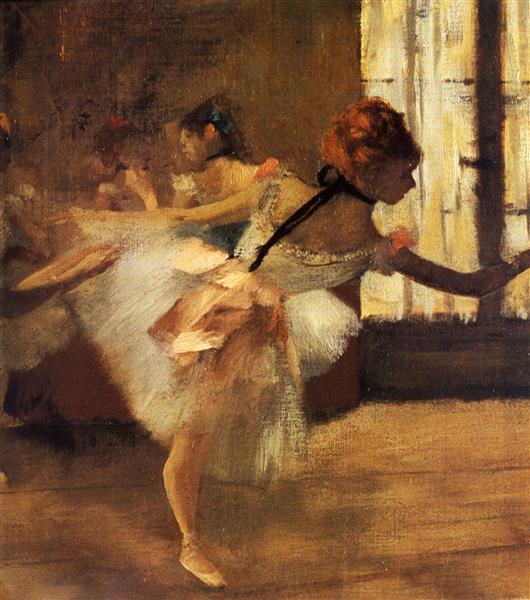Beschrijving
The painting "Repetition of the Dance (Detail)", created by Edgar Degas in 1877, is part of the corpus of works that the artist dedicated to dance, a field in which he achieved a remarkable mastery that distinguishes him within the community of the impressionists. In this piece, Degas reveals his fascination with human movement and, above all, with the representation of the female figure in dance, a recurring theme in his work. The scene, imbued with an intimate and almost voyeuristic atmosphere, offers a window into the disciplined rigidity of choreographic training.
Structurally, the painting is a detail that seems to capture a fraction of a moment of rehearsal. The composition is characterized by an almost painterly approach to reality, where the dancers are arranged on a diagonal that guides the viewer's gaze towards the focal point. Degas uses this device to create a sense of movement and dynamism, even within the stillness of the pause. The strength of the diagonal is accentuated by the interplay of the figures, who seem to be in continuous interaction with each other, suggesting a cycle of effort maintained through repetition and practice.
As for the colour palette, Degas chooses to use soft, earthy tones, evoking a sense of warmth and familiarity. The colours combine to create an almost dreamlike atmosphere, delivering a melancholic vision of the world of ballet, where the light seems to filter through a thin veil. The light in this work, as in many of Degas's other works, plays a crucial role, as it accentuates both the volume and the contours of the figures, bringing a rich and palpable texture to the scene.
The characters that populate this work are the dancers, whose postures rehearse a ballet that seems to trap them between grace and the tension of physical effort. In the "Repetition of the Dance," Degas reinterprets the romantic ideal of the ballerina, presenting her in a context where discipline is at the heart of art. The figures appear tense and concentrated, suggesting both the vulnerability of the artist and the pressure of performance in the realm of ballet. The use of space in the work, where the dancers are framed in an almost tight manner, reinforces the idea of collaborative work, but also the sense of competition inherent in dance.
The choice of detail in this work suggests a more introspective study than the full portraits of some of his other dances. Degas was fascinated by the exploration of the human form, and this is reflected in his ability to bring these figures back to life in positions that tell stories. Through loose brushstrokes and an atmosphere charged with intimacy, he manages to capture the essence of repetition in dance, pointing to the tension between the ephemeral and the enduring, the individual and the collective.
In short, Edgar Degas's "Repetition of the Dance (Detail)" is a testament to the artist's mastery over the depiction of human movement, light, and texture. This work encapsulates not only the beauty of ballet in its purest form, but also the sacrifices and dedication that it entails. Degas, with his unique approach, positions himself as a bridge between classical art and the modern impulse, and in this very detail, he invites us to contemplate the lives of ballerinas and the ceaseless cycle of practice and perfection that characterizes them.
KUADROS ©, a famous painting on your wall.
Hand-made oil painting reproductions, with the quality of professional artists and the distinctive seal of KUADROS ©.
Painting reproduction service with satisfaction guarantee. If you are not completely satisfied with the replica of your painting, we will refund 100% of your money.

